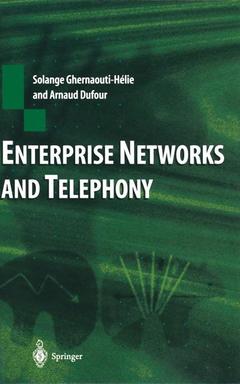Description
Enterprise Networks and Telephony, Softcover reprint of the original 1st ed. 1998
From Technology to Business Strategy
Language: English
Subjects for Enterprise Networks and Telephony:
Publication date: 01-2012
226 p. · 15.5x23.5 cm · Paperback
226 p. · 15.5x23.5 cm · Paperback
Description
/li>Contents
/li>Comment
/li>
A revised and updated translation of the French original, this work deals effectively with local area network technologies and management, offering a broad overview of enterprise telecommunication technologies. Also covered is computer telephony integration (CTI) through a presentation of the main technologies of the domain. A functional description of the main features of network operating systems is proposed and illustrated by Novell IntraNetWare and Windows NT examples, with special emphasis offered on business applications and management issues of these topics. The main interest of the book resides in the dual approach of enterprise networks, covering both technical and managerial elements, providing a global understanding of business applications and management of telecommunications to IT professionals and students. Concrete tools and methods are described, thus offering practical advice of immediate relevance.
1 The Communicating Enterprise.- 1.1 Introduction.- 1.2 Networked Economy and Business Stakes.- 1.3 Networked Enterprise and Added Value.- 1.4 Networks Macrocosm.- 1.5 Conclusion.- 2 Enterprise Local Area Network Features and Operating Mode.- 2.1 Introduction.- 2.2 Notion of Service.- 2.3 Hardware Components.- 2.4 Software Components.- 2.5 Network Interconnection Issues.- 2.6 “Manware” components.- 2.7 Conclusion.- 3 Services and Applications.- 3.1 Introduction.- 3.2 File Management Services.- 3.3 Printing Services.- 3.4 Database Servers.- 3.5 Groupware and Office Automation.- 3.6 Electronic Mail.- 3.7 Internet Access.- 3.8 The Web.- 3.9 The Enterprise Intranet.- 3.10 Conclusion.- 4 Network Operating System.- 4.1 Stakes.- 4.2 The Particular Case of Peer to Peer Networking.- 4.3 Network Operating Systems Features.- 4.4 Additional Functions.- 4.5 Conclusion.- 5 Local Area Network Administration.- 5.1 Managing LANs in a Professional Way.- 5.2 The Network Administrator’s Key Roles.- 5.3 The Network Administrator’s Day-to-day Tasks.- 5.4 Conclusion.- 6 High-speed Local Area Networks.- 6.1 Evolution of Local Networks.- 6.2 Fibre-distributed Data Interface (FDDI).- 6.3 Fast Ethernet.- 6.4 Local Area Networks and ATM.- 6.5 Conclusion.- 7 Voice—Data—Image Telecommunications.- 7.1 Introduction.- 7.2 Telephony: Voice Telecommunications.- 7.3 Data Telecommunication.- 7.4 Voice—Data Hybrid Satellite Systems.- 7.5 Image Telecommunication.- 7.6 Support Networks.- 7.7 Conclusion.- 8 PBX.- 8.1 Introduction.- 8.2 PBX Features.- 8.3 The PBX: A Central Communication Node.- 8.4 CENTREX.- 8.5 Conclusion.- 9 Computer Telephony Integration (CTI).- 9.1 Introduction.- 9.2 From Utopia to Reality.- 9.3 Reasons for Integrating Computing and Telephony.- 9.4 Call Centres.- 9.5Applications and Services.- 9.6 Actors and Strategies.- 9.7 Conclusion.- 10 Mastering Telecommunications.- 10.1 Introduction.- 10.2 Strategic Planning.- 10.3 Telecommunications Planning.- 10.4 Modelling and Simulation.- 10.5 Quality Assurance.- 10.6 Conclusion.- 11 Network Management.- 11.1 Introduction.- 11.2 Network Management: The Strategic Viewpoint.- 11.3 Network Management: The Tactical Viewpoint.- 11.4 Network Management: The Operational Viewpoint.- 11.5 Outsourcing and Facilities Management.- 11.6 Normative Considerations.- 11.7 Conclusion.- 12 Network Security Management.- 12.1 Introduction.- 12.2 IT Risk Management.- 12.3 Security Policy.- 12.4 Threats to the Network.- 12.5 Conclusion.- 13 Network Audit.- 13.1 Introduction.- 13.2 Different Types of Audit.- 13.3 Computer Management Control.- 13.4 Computer Operations Management Internal Control.- 13.5 Information Systems Audit.- 13.6 Audit, Quality and ISO 9000 Certification.- 13.7 Conclusion.
Telecommunications is an ever-expanding field of increasing importance for business Completely revised and updated version of the French publication Offers practical advice to IT professionals and students which will have immediate relevance
© 2024 LAVOISIER S.A.S.
These books may interest you

Telecommunications Management 56.31 €



